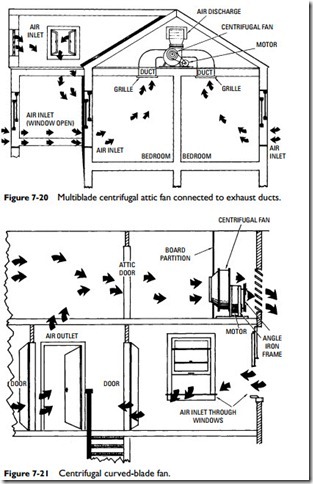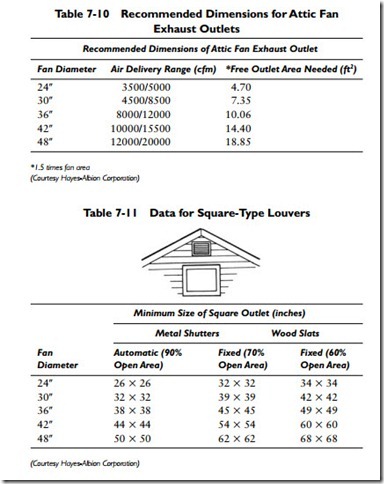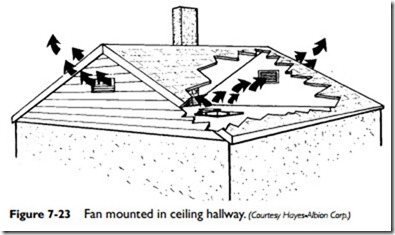Air Volume Control
Sometimes it becomes necessary to vary the air volume handled by a fan. The following methods can be used for this purpose:
1. Dampers placed in the duct system.
2. Changing the pulley on the fan motor.
3. Changing the pulley on the fan.
4. Using variable-speed pulleys.
5. Using variable-speed motors.
6. Using variable inlet vanes on fans.
7. Reduction or increase of speed through power control.
Noise Control
In order to decrease the noise associated with the air exchange equipment, the following recommendations should be observed:
1. The equipment should be located a reasonable distance from important rooms.
2. The fans should be of proper size and capacity to obtain reasonable operating speed.
3. The equipment should be mounted on resilient bases made from a sound-dampening material.
4. When possible, the quieter high-speed AC motors with belt- driven fans should be used.
Fan Applications
Many different fans are used in ventilation and air-circulation systems, and these fans are classified on the basis of certain design and operating characteristics. Fan applications, on the other hand, are classified by the specific function they serve in the ventilation or air- circulation system. Among the numerous fan applications used for ventilation and air circulation are the following:
1. Attic fans
2. Exhaust fans
3. Circulating fans
4. Kitchen fans
5. Cooling tower fans
6. Unitary system fans
Attic fans are generally propeller types used during the summer to draw the cool night air through the structure and discharge it from the attic. The air can be discharged through windows or grilles or directly through an attic exhaust fan. The air is circulated, not conditioned.
Exhaust fans are used in local ventilation to remove contaminants at their source, or as a general means of discharging air from a space (for example, attic exhaust fans, wall fans, bathroom fans). Hood exhaust fans used with a duct system are generally centrifugal types. Because wall fans operate against very low resistance or no resistance at all, they are most commonly propeller types.
Circulating fans and kitchen fans are propeller types used for air circulation purposes. Cooling tower fans are also generally propeller types, although centrifugal fans have also been used in installations requiring a forced draft.
Unitary system fans are centrifugal or propeller fans used in unit ventilators, unit heaters, unit humidifiers, and similar types of equipment. A propeller fan is used in these units when no ductwork exists.
Attic Ventilating Fans
A noninsulated attic on a hot summer day will experience temperatures as high as 130˚F to 150˚F. This accumulated heat seeps down through the ceiling and raises the temperatures in the rooms below, making living and sleeping areas very uncomfortable. This hot air from an uninsulated attic also increases the load on the air conditioner, which will raise the energy costs during the summer months. After sunset, the outside temperature sinks to pleasant cool levels, but the indoor air (especially in the upstairs bedrooms of a two- story house) remains uncomfortably hot with temperature readings that can reach as high as 85˚F. This condition results from the fact that a house loses accumulated heat at a very slow rate.
This condition can be alleviated considerably by installing an attic ventilating fan. Such a fan placed in the attic will cool the air by replacement; that is, it will ventilate rather than condition. An attic ventilating fan can reduce temperatures in the attic by as much as 20 to 30 percent, and by approximately 10 to 15 percent in the bedrooms immediately below the attic.
Attic ventilating fans are controlled by a thermostat located in the attic or in the fan housing. The thermostat turns the fan on at a preset temperature and shuts it off when the temperature is lowered to the minimum setting in the thermostat preset temperature range. Many attic fans are equipped with a firestat, which will shut off the fan if there is a fire in the house.
In areas where high humidity is a problem, the fan should be equipped with a humidistat to remove excess moisture from the attic during the winter months. Moisture accumulating in the attic will contribute to the formation of ice dams on the roof. Ice will also form on the rafter surfaces inside the attic, which may lead to rot and damage to the roof framing.
Because of the low static pressures involved (usually less than
inch), disc or propeller fans with the blade mounted directly on the motor shaft are generally recommended for attic installation. It is recommended that these fans have quiet operating characteristics and sufficient capacity to give at least 30 air changes per hour.
The two general types of attic fans in common use in houses and other buildings are the following:
1. Boxed-in fans
2. Centrifugal fans
The boxed-in attic fan is installed within the attic in a box or suitable housing, located directly over a ceiling grille or in a bulk- head enclosing an attic stair. This type of fan can be connected to individual room grilles by means of a duct system.
In operation, outside cool air entering through the windows in the downstairs rooms is discharged into the attic space and escapes to the outside through louvers, dormer windows, or screened open- ings under the eaves. A general arrangement showing a typical installation of this type of fan is illustrated in Figure 7-19.
The installation of a multiblade centrifugal attic fan is shown in Figure 7-20. At the inlet side, the fan is connected to exhaust ducts leading to grilles, which are placed in the ceiling of the two bed- rooms. The air exchange is accomplished by admitting fresh air through open windows, moving it up through the suction side of the fan, and finally discharging it through louvers.
The fan shown in Figure 7-21 is of the centrifugal curved-blade type, mounted on a light angle-iron frame, which supports the fan wheel, shaft, and bearings, with the motor that supplies the motive power to the fan through a belt drive.
The air inlet in this installation is placed close to a circular open- ing that is cut in an airtight board partition, which serves to divide the attic space into a suction and discharge chamber. The air is admitted through open windows and doors and then drawn up the attic stairway through the fan into the discharge chamber, from which it flows through the attic open window.
For best results, the outlet area for an attic fan should be 11⁄2 times the area of the fan. Satisfactory results will be obtained as long as the area is at least equal to the blade area of the fan. Recommended dimensions for attic fan exhaust outlets are given in Table 7-9.
Tables 7-10, 7-11, and 7-12 provide data for square- and triangular-type louvers used with various fan diameters. These tables
only 50 percent free area; therefore, the boxing must have a total area twice that of the inlet opening.
The location of the attic fan always depends on the design of the structure. In a house having a suitably sized window in an attic end wall or dormer, the best results (and fewest construction problems) can usually be obtained by mounting the fan directly against the window (see Figure 7-22). An automatic shutter should be installed outside the window for window-mounted fans. If the window is opened and the fan is mounted inside the opening, louvers should be installed a few inches in front of the fan to keep rain out of the attic.
In one-floor houses, the ceiling openings can be installed in any convenient central location (see Figure 7-23). In houses of two or more stories, the opening is generally located in the ceiling of the top-floor hallway. Again, a central location is usually best. The ceiling opening and its accompanying grille or shutter must be of sufficient size to avoid excessive resistance to airflow, permitting the airstream to pass through at a moderate, quiet velocity.
Some attic fans require periodic lubrication of their motor bearings. Check the fan manufacturer’s installation and operating instructions for the recommended lubrication schedule. Lubricate the bearings by pouring oil into the oil cups. Fan motors with sealed bearings do not require lubrication.
Clean the fan housing and blades in the spring before the begin- ning of the cooling season. The screens on the fan vent, soffits, and attic vents should also be cleaned at this time. Blocked vents will prevent air from being drawn into or exhausted from the attic.




